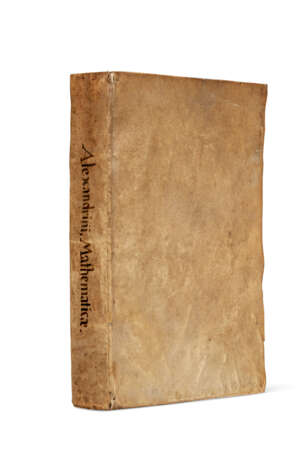ID 887842
Lot 69 | Mathematicae Collectiones
Valeur estimée
$ 4 500 – 6 000
First edition of Pappus’ Collection, also known as the Synagogue, translated into Latin by Commandino. Pappus was one of the last in a long line of accomplished Alexandrine mathematicians, and his work comprises eight volumes of commentaries on the ancient mathematical canon. It is “by far the most important of Pappus’ works ... without it, much of the geometrical achievement of his predecessors would have been lost forever... The Collection deals with the whole body of Greek geometry, mostly in the form of commentaries on texts which it is assumed the reader has to hand. It reproduces known solutions to problems in geometry; but it also frequently gives Pappus’ own solutions, or improvements and extensions to existing solutions. Thus Pappus handles the problem of inscribing five regular solids in a sphere in a way quite different from Euclid; gives a broader generalization that Euclid to the famous Pythagorean theorem, and provides a demonstration of squaring the circle which is quite different from the method of Archimedes (who used a spiral) or that of Nicomedes (who used the conchoid).
“Perhaps the most interesting part of the Collection, measured by its influence on modern mathematics, is Book VII, which is concerned with the problems of determining the locus with respect to three, four, five, six or more than six lines. Pappus’ work in this field was called ‘Pappus’ problem’ by René Descartes, who demonstrated that the difficulties which Pappus was unable to overcome could be got round by the use of his new algebraic symbols. Pappus thus came to play an important, if minor, role in the founding of Cartesian analytical geometry. And it is another mark of his originality and skill that he spent much time working on the problem of drawing a circle in such a way that it will touch three given circles, a problem sophisticated enough to engage the interest, centuries later, of both François Viète and Isaac Newton.
“For his own originality, even if his chief importance is as the preserver of Greek scientific knowledge, Pappus stands (with Diophantus) as the last of the long and distinguished line of Alexandrian mathematicians” (Hutchinson Dictionary of Scientific Biography). Adams P-223; Riccardi I 364 11
Folio (306 x 202mm). Woodcut printer's device on title, numerous woodcuts in text and several historiated woodcut initials (dampstain at end, a few spots, repair to blank margin of one leaf). Contemporary Italian vellum, manuscript title on spine. Provenance: inscription on flyleaf.
| Adresse de l'enchère |
CHRISTIE'S 8 King Street, St. James's SW1Y 6QT London Royaume-Uni | |
|---|---|---|
| Aperçu |
| |
| Téléphone | +44 (0)20 7839 9060 | |
| Commission | see on Website | |
| Conditions d'utilisation | Conditions d'utilisation |






